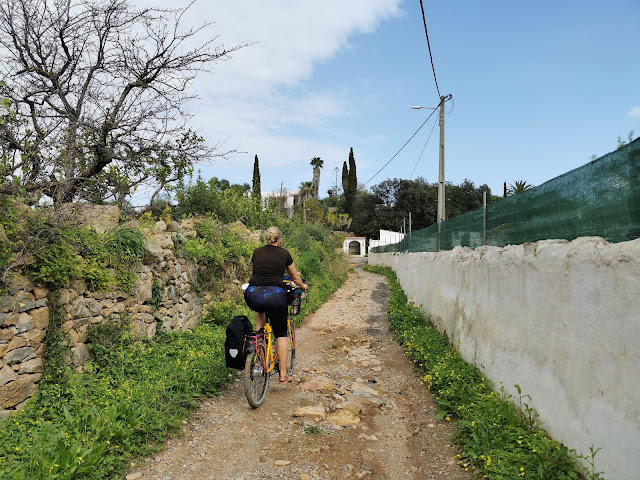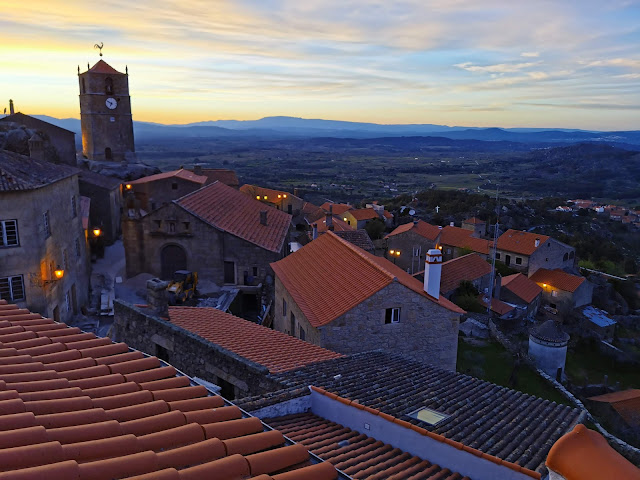Sneaking past police checkpoints is not something I thought I would do in Western Europe, but here we are. The pandemic is still raging and the restrictions are strict, but our restlessness has become overwhelming and we must leave our isolation before we go mad. We cycle out of town on back streets to avoid being questioned. We are not allowed to cross municipal borders without a good reason and we are not sure "cycling home to Sweden" is a good enough excuse.
 |
| No police here! |
We spend a few days in the mountains with our friend and landlord before we start cycling north. We are exhausted after spending another four months in isolation and the road is hilly. Our bodies ache like never before. We have promised each other so many times not to lose fitness but failed to keep that promise each time. Now we have only ourselves to blame. Again.
 |
| Friends in the mountains. |
 |
| Hilly and out of shape! |
We stick to small roads and tractor paths but occasionally we have to cycle a short distance on a road. Suddenly we see a police checkpoint and they have spotted us. It feels ridiculous to turn around and almost as absurd to remain motionless and stare at them. We cycle forward and see what happens. The cops step back almost demonstratively and let us pass, but stop the next car. We probably looked like a bit too much paperwork, we think.
 |
| Camping with company. |
From time to time we cycled on one of the many Caminho de Santiago and the thought occurred to us that we should follow one of them to Santiago de Compostela. Galicia was the last corner of Spain that we had not yet visited and it seemed like a good destination for the moment. We moved slowly and aimlessly, partly because of our poor fitness but mostly because we were still hoping that the restrictions would end soon. Something we had been hoping for for over a year by now.
 |
The Caminho sign pointing Sofia in the right direction.
|
 |
| The police can't track you through water, or so I've heard. |
We reached Evora almost exactly a year to the day we passed here last time, having spent the night there with our bikes in boxes after a hasty flight from Tbilisi to Lisbon. It felt so recent at the same time as it felt like an eternity had passed. Time can be strange.
 |
| Cromeleque dos Almendres, the largest group of menhirs in Iberia. |
 |
| Evora again. |
We cycled along the Caminho on and off but also had to plan the route to include the places we were interested in seeing. Despite having cycled through Portugal twice before we hadn't explored the interior much, especially the mountain range of Serra da Estrela.
 |
| View over the village of Monsanto from our roof terrace. |
 |
| Church in Covilhã, at the base of the highest mountain in mainland Portugal. |
 |
| On our way towards the top. |
 |
| Torre, highest peak in mainland Portugal at 1993 meters. |
The climb up to Torre, the highest point in mainland Portugal, reminded us that we were still out of shape. We didn't conquer it in a day, but had to set up camp with a few hundred vertical metres left to the top. As we got closer to the summit snow started to appear on the ground but it was not until we were on our way down again that we got bothered by the cold. Sofia had no gloves and had to wrap her hands in her scarf to protect them from the wind chill.
 |
| It's important to stay warm! |
I have a list. I have a list of things I want to see and experience, a list that is updated every time I hear about something new, obscure and exciting. The list is long and unorganized and is really just a list of things I haven't yet seen and done. It's not that I have to do everything on the list during my lifetime, that would be impossible, but it's useful to look through when I'm at a new destination, so I don't miss anything exciting nearby. Even so, I frequently discover things I want to see after we've already departed a place. Hence, keeping a list.
One of the oldest entry on this list was Covão dos Conchos, a remote lake with a manmade overflow spillway looking like the lake got a hole in it. It was with great satisfaction that I was able to cross a row off the list, something that happens remarkably seldom considering how much I travel. Perhaps because the list mostly consists of arcane things like this.
 |
| A dream come true! |
 |
| Finally some downhill! |
We arrived in the extremely picturesque, almost fairy-tale like, village of Piódão to the surprise of the inhabitants. Due to the restrictions, the usually crowded village was completely devoid of tourists and they were taking the opportunity to renovate their buildings. The downside, of course, was that all the establishments were closed, but one of the cafés at the square turned on the coffee maker for our sake.
 |
| Foz d'Égua. |
 |
| Piódão. |
We left the mountains and as soon as we got closer to the coast the rain started pouring, the traffic increased dramatically, and I got a flat tire. We needed a rest and stayed a few days by the sea in Furadouro, while waiting for the sun to shine again. We cycled leisurely along the coast, a route we had previously cycled with Anna and Flo two years ago. As we approached Spain, we began to get concerned about how we would get across the border. The restrictions remained in place, and the majority of the bridges connecting the two countries were closed.
 |
| Igreja Matriz de Santa Maria de Válega. |
 |
| Our apartment in Furadouro. |
 |
| Skinny dipping by Cascata do Pincho. |
 |
| Don't come here with your diseases! |
We reached Monção, the only border town with an open bridge that also permitted bicycles. We kept our fingers crossed and gambled on cycling into Spain. The border control officer asked curiously what we were doing and then let us through without a problem. It felt like we had cleared a significant hurdle.
 |
Waiting nervously to cross a border.
|
 |
In Spain. Again.
|
 |
| Almost there! |
Now we are starting to meet other pilgrims following the Camino de Santiago. Not many, but a few groups every day. Some of the restrictions began to be relaxed and the cities were suddenly filled with drunken young people in desperate need of a social life. Travel restrictions were still strict, however.
We reached Santiago de Compostela where we found out we should have stamped a pilgrim's pass along the way to count as successful pilgrims who completed their Camino. Oh well, maybe next time.
 |
| The classic picture for a completed journey, in front of Catedral de Santiago de Compostela. |
The road does not end in Santiago de Compostela, however, but continues out to the coast, to Fisterra, "the end of the world". We didn't have much else to do and cycled the last part mostly to kill time, still trying to hold on to the hope that the world will very shortly return to normal. Unfortunately the world was the same when we reached the coast and we ran out of steam to continue.
 |
| Ponte Maceira over Rio Tambre. |
We asked around and by incredible luck, we got to hitch a ride with a moving truck and 36 hours later we were back home in Sweden, pitching our tent in places we had camped three years earlier.
What now?
Don't know.
 |
| We have reached the end. |




























Comments
Post a Comment